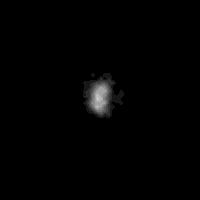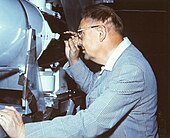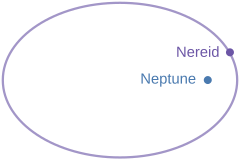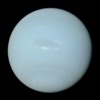Nereid (moon)
 Nereid imaged by Voyager 2 in 1989 | |
| Discovery[1] | |
|---|---|
| Discovered by | Gerard P. Kuiper |
| Discovery date | 1 May 1949 |
| Designations | |
Designation | Neptune II |
| Pronunciation | /ˈnɪəriəd/ NEER-ee-əd[2] |
Named after | Νηρηΐδες Nērēḯdes |
| Adjectives | Nereidian or Nereidean (both /ˌnɛriˈɪdiən/ NERR-ee-ID-ee-ən)[3] |
| Orbital characteristics[4] | |
| Epoch 1 January 2020 (JD 2458849.5) | |
| Observation arc | 27,656 d (75.72 yr) |
| 5,504,000 km (0.03679 AU) | |
| Eccentricity | 0.749 |
| 360.14 d (0.9860 yr) | |
| 318.0° | |
| 0° 59m 58.597s / day | |
| Inclination | 5.8° (to the ecliptic) 7.090° (to local Laplace plane)[4] |
| 326.0° | |
| 290.3° | |
| Satellite of | Neptune |
| Physical characteristics | |
| 357±13 km[5] | |
| Flattening | ≤0.23[a] |
| Mass | 3.57×1019 kg (5.98×10−6 M🜨) |
Mean density | 1.5 g/cm3 (assumed)[6] |
| ≈0.075 m/s2 (0.0076 g) | |
| 11.594±0.017 h[5] | |
| Albedo | 0.24[5] |
| Temperature | ≈50 K (mean estimate) |
| 19.2[citation needed] | |
| 4.4[7] | |
Nereid, or Neptune II, is the third-largest moon of Neptune. It has the most eccentric orbit of all known moons in the Solar System.[4] It was the second moon of Neptune to be discovered, by Gerard Kuiper in 1949.
Discovery and naming
[edit]
Nereid was discovered on 1 May 1949 by Gerard P. Kuiper using photographic plates taken with the 82-inch telescope at the McDonald Observatory. He proposed the name in the report of his discovery. It is named after the Nereids, sea-nymphs of Greek mythology and attendants of the god Neptune.[1] It was the second moon of Neptune to be discovered, and the last before the arrival of Voyager 2 (not counting a single observation of an occultation by Larissa in 1981).[8]
Physical characteristics
[edit]Nereid is third-largest of Neptune's satellites, and has a mean radius of about 180 kilometres (110 mi).[5] It is by far the largest normal irregular satellite known,[9] having about two-thirds the mass of all irregular moons combined.[10] (Triton is much larger, but is very unusual for an irregular satellite.) Nereid also accounts for about 98% of the mass of Neptune's entire irregular satellite system altogether (excluding Triton), which is similar to the situation of Phoebe at Saturn (the second-largest normal irregular moon in the Solar System).[10]
The shape of Nereid is unknown.[11] Nereid is similar in size to Saturn's moon Mimas, though Nereid is denser. Since 1987 some photometric observations of Nereid have detected large (by ~1 of magnitude) variations of its brightness, which can happen over years and months, but sometimes even over a few days. They persist even after a correction for distance and phase effects. On the other hand, not all astronomers who have observed Nereid have noticed such variations. This means that they may be quite chaotic. To date there is no credible explanation of the variations, but, if they exist, they are likely related to the rotation of Nereid. Nereid's rotation could be either in the state of forced precession or even chaotic rotation (like Hyperion) due to its highly elliptical orbit.
In 2016, extended observations with the Kepler space telescope showed only low-amplitude variations (0.033 magnitudes). Thermal modeling based on infrared observations from the Spitzer and Herschel space telescopes suggest that Nereid is only moderately elongated with a maximum aspect ratio of 1.3:1, which disfavors forced precession of the rotation.[5] The thermal model also indicates that the surface roughness of Nereid is very high, likely similar to the Saturnian moon Hyperion.[5]
Spectrally, Nereid appears neutral in colour[12] and water ice has been detected on its surface.[13] Its spectrum appears to be intermediate between Uranus's moons Titania and Umbriel, which suggests that Nereid's surface is composed of a mixture of water ice and some spectrally neutral material.[13] The spectrum is markedly different from minor planets of the outer solar system, centaurs Pholus, Chiron and Chariklo, suggesting that Nereid formed around Neptune rather than being a captured body.[13]
Halimede, which displays a similar gray neutral colour, may be a fragment of Nereid that was broken off during a collision.[12]
Orbit and rotation
[edit]Nereid orbits Neptune in the prograde direction at an average distance of 5,504,000 km (3,420,000 mi), but its high eccentricity of 0.749 takes it as close as 1,381,500 km (858,400 mi) and as far as 9,626,500 km (5,981,600 mi).[4]

The unusual orbit suggests that it may be either a captured asteroid or Kuiper belt object, or that it was an inner moon in the past and was perturbed during the capture of Neptune's largest moon Triton.[13] If the latter is true, it may be the only survivor of Neptune's original (pre-Triton capture) set of regular satellites.[14]
In 1991, a rotation period of Nereid of about 13.6 hours was determined by an analysis of its light curve.[15] In 2003, another rotation period of about 11.52 ± 0.14 hours was measured.[9] However, this determination was later disputed, and other researchers for a time failed to detect any periodic modulation in Nereid's light curve from ground-based observations.[11] In 2016, a clear rotation period of 11.594 ± 0.017 hours was determined based on observations with the Kepler space telescope.[5]
Exploration
[edit]The only spacecraft to visit Nereid was Voyager 2, which passed it at a distance of 4,700,000 km (2,900,000 mi)[16] between 20 April and 19 August 1989.[17] Voyager 2 obtained 83 images with observation accuracies of 70 km (43 mi) to 800 km (500 mi).[17] Prior to Voyager 2's arrival, observations of Nereid had been limited to ground-based observations that could only establish its intrinsic brightness and orbital elements.[18] Although the images obtained by Voyager 2 do not have a high enough resolution to allow surface features to be distinguished, Voyager 2 was able to measure the size of Nereid and found that it was grey in colour and had a higher albedo than Neptune's other small satellites.[8]
If selected, The Arcanum mission[19] would do a flyby of Nereid before its primary purposes of orbiting Neptune and observing Triton.[20]
See also
[edit]Notes
[edit]References
[edit]- ^ a b Kuiper, G. P. (August 1949). "The Second Satellite of Neptune". Publications of the Astronomical Society of the Pacific. 61 (361): 175–176. Bibcode:1949PASP...61..175K. doi:10.1086/126166.
- ^ "Nereid". Oxford English Dictionary (Online ed.). Oxford University Press. (Subscription or participating institution membership required.)
- ^ "nereidian, nereidean". Oxford English Dictionary (Online ed.). Oxford University Press. (Subscription or participating institution membership required.)
- ^ a b c d Jacobson, R. A. — AJ (2009-04-03). "Planetary Satellite Mean Orbital Parameters". JPL satellite ephemeris. JPL (Solar System Dynamics). Archived from the original on October 14, 2011. Retrieved 2011-10-26.
- ^ a b c d e f g h Kiss, C.; Pál, A.; Farkas-Takács, A. I.; Szabó, G. M.; Szabó, R.; Kiss, L. L.; et al. (April 2016). "Nereid from space: Rotation, size and shape analysis from K2, Herschel and Spitzer observations" (PDF). Monthly Notices of the Royal Astronomical Society. 457 (3): 2908–2917. arXiv:1601.02395. Bibcode:2016MNRAS.457.2908K. doi:10.1093/mnras/stw081.
- ^ "Planetary Satellite Physical Parameters". JPL (Solar System Dynamics). Archived from the original on 2010-05-27. Retrieved 2011-10-26.
- ^ "M.P.C. 115892" (PDF). Minor Planet Circular. Minor Planet Center. 27 August 2019.
- ^ a b Smith, B. A.; Soderblom, L. A.; Banfield, D.; Barnet, C.; Basilevsky, A. T.; Beebe, R. F.; Bollinger, K.; Boyce, J. M.; Brahic, A. (1989). "Voyager 2 at Neptune: Imaging Science Results". Science. 246 (4936): 1422–1449. Bibcode:1989Sci...246.1422S. doi:10.1126/science.246.4936.1422. PMID 17755997. S2CID 45403579.
- ^ a b Grav, T.; M. Holman; J. J. Kavelaars (2003). "The Short Rotation Period of Nereid". The Astrophysical Journal. 591 (1): 71–74. arXiv:astro-ph/0306001. Bibcode:2003ApJ...591L..71G. doi:10.1086/377067. S2CID 8869351.
- ^ a b Denk, Tilmann (2024). "Outer Moons of Saturn". tilmanndenk.de. Tilmann Denk. Retrieved 25 February 2024.
- ^ a b Schaefer, Bradley E.; Tourtellotte, Suzanne W.; Rabinowitz, David L.; Schaefer, Martha W. (2008). "Nereid: Light curve for 1999–2006 and a scenario for its variations". Icarus. 196 (1): 225–240. arXiv:0804.2835. Bibcode:2008Icar..196..225S. doi:10.1016/j.icarus.2008.02.025. S2CID 119267757.
- ^ a b Grav, Tommy; Holman, Matthew J.; Fraser, Wesley C. (2004-09-20). "Photometry of Irregular Satellites of Uranus and Neptune". The Astrophysical Journal. 613 (1): L77 – L80. arXiv:astro-ph/0405605. Bibcode:2004ApJ...613L..77G. doi:10.1086/424997. S2CID 15706906.
- ^ a b c d Brown, Michael E.; Koresko, Christopher D.; Blake, Geoffrey A. (December 1998). "Detection of Water Ice on Nereid". The Astrophysical Journal. 508 (2): L175 – L176. Bibcode:1998ApJ...508L.175B. CiteSeerX 10.1.1.24.1200. doi:10.1086/311741. PMID 11542819. S2CID 17451226.
- ^ Brozović, M.; Showalter, M. R.; Jacobson, R. A.; French, R. S.; Lissauer, J. J.; de Pater, I. (March 2020). "Orbits and resonances of the regular moons of Neptune". Icarus. 338: 113462. arXiv:1910.13612. Bibcode:2020Icar..33813462B. doi:10.1016/j.icarus.2019.113462. S2CID 204960799.
- ^ Williams, I.P.; Jones, D.H.P.; Taylor, D.B. (1991). "The rotation period of Nereid". Monthly Notices of the Royal Astronomical Society. 250: 1P – 2P. Bibcode:1991MNRAS.250P...1W. doi:10.1093/mnras/250.1.1p.
- ^ Jones, Brian (1991). Exploring the Planets. Italy: W.H. Smith. pp. 59. ISBN 978-0-8317-6975-8.
- ^ a b Jacobson, R.A. (1991). "Triton and Nereid astrographic observations from Voyager 2". Astronomy and Astrophysics Supplement Series. 90 (3): 541–563. Bibcode:1991A&AS...90..541J.
- ^ "PIA00054: Nereid". NASA. 1996-01-29. Retrieved 2009-11-08.
- ^ McKevitt, J.E.; Beegadhur, S.; Ayin-Walsh, L.; Dixon, T.; Criscola, F.; Patadia, D.; Bulla, S.; Galinzoga, J.; Wadsworth, B.; Bornberg, C.; Sharma, R.; Moore, O.; Kent, J.; Zaripova, A.; Parkinson-Swift, J.; Laad, A. (2024). "Concept of operations for the Neptune system mission Arcanum". The Aeronautical Journal. 128 (1321): 469–488. doi:10.1017/aer.2023.114.
- ^ McKevitt, James; Bulla, Sophie; Dixon, Tom; Criscola, Franco; Parkinson-Swift, Jonathan; Bornberg, Christina; Singh, Jaspreet; Patel, Kuren; Laad, Aryan; Forder, Ethan; Ayin-Walsh, Louis; Beegadhur, Shayne; Wedde, Paul; Bharath Simha Reddy Pappula; McDougall, Thomas; Foghis, Madalin; Kent, Jack; Morgan, James; Raj, Utkarsh; Heinreichsberger, Carina (2021). "An L-class Multirole Observatory and Science Platform for Neptune". arXiv:2106.09409 [astro-ph.IM].




